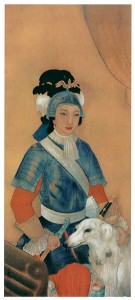Hashimoto Kansetsu 橋本関雪, a Kyoto-based painter, lived from 1883 to 1945. His home in Kyoto was a carefully cultivated assemblage of pavilions and greenery, now open to the public for a small fee, with a gallery displaying some of his works. His paintings deal mostly with natural subjects, some of which can be seen here. One picture is of a more historical nature, though. It is a copy of one of the portraits of the Qianlong Emperor’s famous concubine from Xinjiang, who was known variously as Rong Fei 容妃, Xiang Fei 香妃 (the “Fragrant Concubine”), or among Uyghurs as Iparkhan. The original, which belongs to the National Palace Museum in Taiwan, is attributed to the Jesuit artist Giuseppe Castiglione (Lang Shining 郎世寧). There are, in fact, quite a few different pictures thought to be the Castiglione portrait, as James Millward has discussed (“An Uyghur Muslim in Qianlong’s Court: The Meanings of the Fragrant Concubine,” Journal of Asian Studies 53, no. 2 [1994]: 427-58.). To this collection, then, we can add this slightly Japanese-looking Xiang Fei, now hanging in the National Diet of Japan:

